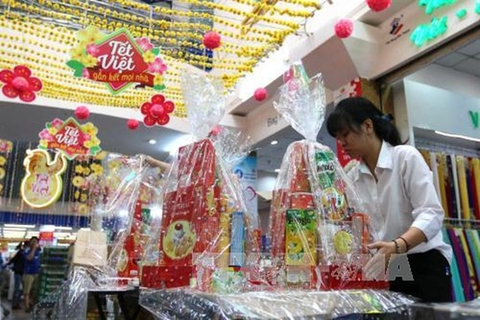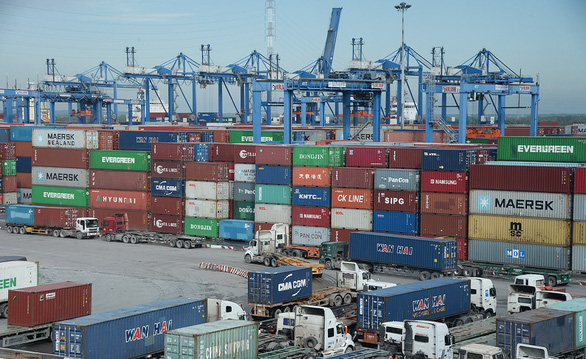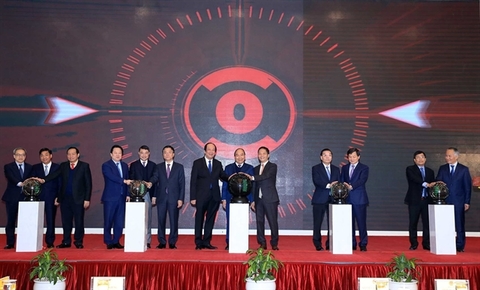Innovation the name of the game for retailers
Innovation the name of the game for retailers
Applying technology in the retail industry is the next step in its evolution and will enable the offering of new experiences for customers while, conversely, retailers that are sluggish to update and innovate face being left behind.Technology is contributing to the convenience of shopping activities in movement and in payments. In 2019, retail chains VinMart and VinMart+ launched their Scan&Go function, which is integrated on the VinID application to remove long periods for payment, remote shopping, and delivery.
Employing VinMart Scan&Go, instead of putting every product into a basket and queuing to pay, customers can start the VinID application, scan the barcode on the products, and pay at a priority desk. Customers can also pay at the shop and the goods will be delivered within two or four hours later.
As using Scan&Go takes around 30 seconds, up to 90 per cent faster than usual, technology apps like these are contributed significantly towards the convenience of shopping, as well as enabling new experiences for customers.
Recently, convenience stores are becoming a popular segment for numerous foreign brands like Circle K, K-mart, and Shop&Go, in addition to local names like VinMart+ and Bach Hoa Xanh, which are rising in Vietnam in a way that was fairly rare only five years ago. Besides their dense store network, these stores also provide delivery services and online shopping.
These modern convenience store chains have reported remarkable growth over recent years. The retail segment of conglomerate Vingroup before being recently acquired by Masan Group increased the number of stores to nearly 2,200 for VinMart and VinMart+, while it was 1,800 at the end of 2018. Moreover, there were 241 VinPro and Vien Thong A stores, with growth of revenue at 16 per cent from VND13 trillion ($565.2 million) in 2017 to VND19.5 trillion ($847.8 million) in 2018.
The development of modern models combined with technology is contributing to strangling the traditional retail chains. In addition to grocery stores and wet markets, supermarkets like Big C, Lotte Mart, and MM Mega Market are also struggling with new rivals.
As one of the oldest supermarkets in Vietnam, Big C was always traditionally popular as one of the biggest retailers. However, its market share has been struggling, with some of its supermarkets reporting negative or very low growth over the last few years, including the Big C stores in Thang Long, An Lac, Haiphong, Binh Duong, and Dong Nai.
Another player entering Vietnam as early as Big C, Metro Cash & Carry Vietnam, which was in early 2017 changed into Thailand’s MM Mega Market Vietnam, has been operating quietly after the acquisition in 2016. A favourite shopping destination at the weekend for families, MM Mega Market is being competed by modern commerce centres including Japan’s AEON Mall. As a result, the chain’s expansion plan to add five new centres each year has been left open.
Meanwhile, some retailers are exploring niche market in residential areas. In recent years, Saigon Co.op has been promoting small-scaled Co.op stores specialising in fresh and frozen food. The retailer has already set foot in the north with three Co.op Food stores at the end of 2018, three Co.opmart SCA supermarkets (after acquiring the French Auchan chain) in Hanoi, and 72 Co.op Smile grocery stores targeting teenagers.
Worldwide, retailers are being forced to close stores because they cannot adapt to new trends. Sears Holdings, a 125-year-old US retailer, went bankrupt at the end of 2018 due to the fierce competition of e-commerce.
According to statistics from Coresight Research, a US-based research and advisory firm, over 9,300 stores closed in 2019, considered another bruising year for many American retailers. This is the highest number for seven years.
Thousands more store closings could be on the way in the coming years as online shopping continues to replace purchases at physical stores and eat into retailers’ profits. High debt levels and rent have also burdened traditional retailers.
Online sales make up around 16 per cent of retail sales today, but they will rise to 25 per cent by 2026, according to a report from Switzerland’s UBS, a global firm providing financial services. That could force up to 75,000 more stores to close by 2026, including more than 20,000 clothing stores and about 10,000 consumer electronics stores. Thousands of home furnishings and sporting goods stores will also need to shut as online shopping grows rapidly.
Enable overseas markets
Against the bruising situation of traditional retailers, online channels are evolving remarkably, especially Amazon, Alibaba, and some local platforms like Lazada, Shopee, and Tiki. Along with the evolution of the internet and youth tech knowledge, e-commerce is a useful bridge for the retail industry and even small- and medium-sized enterprises (SMEs) to touch overseas markets, especially in the integration process of Vietnam.
In addition to the support of technology platforms, Amazon Global Selling also established a dedicated team to better support Vietnamese SMEs in their cross-border e-commerce and business expansion activities, thanks to Amazon’s international customers. Amazon Global Selling provides professional knowledge related to the sales of products on the Amazon website to Vietnam’s retailers.
Meanwhile, the region’s biggest e-commerce platform Alibaba has co-operated with Fado to support SMEs reaching overseas markets. Pham Dat, CEO of Fado, said that Vietnam’s businesses could introduce their goods to 260 partners across 240 countries and territories. Based on this business-to-business platform, local retailers will find it easier to locate cross-border customers, increase orders, and exercise payments.
As a result, e-commerce platforms and the support of technology applications are expected to increase export volumes and create opportunity for local retailers to carry out directly export without expensive costs for renting offline stores.
James Dong, CEO of Lazada Vietnam and Thailand told VIR, “Probably very likely from next year, we’re going to empower a lot of Vietnamese to sell to other ASEAN countries through cross-border trading. Vietnam has a large manufacturing base, and it has a higher chance of being more successful than some other countries in terms of selling elsewhere in Southeast Asia.”
Time and money
In addition to competing with e-commerce platforms that impact offline retail, in order to develop a modern retail industry and catch up with the trend, traditional retailers could change the measures of shopping to bring new experience. In Singapore, supermarkets without cashiers are quite popular. With some automatic cash registers, customers can pick all goods into baskets, scan their barcode and pay via card. Moreover, some cashless supermarkets in Singapore are being operated by robots.
There, customers buying 10 or fewer grocery items can use their smartphones to scan each item and pay using the Honestbee app. According to Pauline Png, vice president and managing director at Habitat by Honestbee, a Singaporean delivery firm, by automating the checkout process, it frees them up from things like queuing, and they have an extra five or 10 minutes to maybe eat or get a coffee. Besides a fully automated checkout system, Habitat by Honestbee also features 15 food stalls, where customers can have a meal while waiting for their groceries to be packed.
According to retail expert Vu Vinh Phu, the modern retail model makes up 26 per cent of market share only. However, growth speed was 11 per cent in 2018, and is estimated at higher in the next few years. Meanwhile, traditional retail captures 70 per cent of market share but growth was at only 1 per cent.
“This opens opportunities for the leading players that research and apply high-tech into management, operations, and sales to lure more customers,” said Phu.
As a result, traditional retail and online retail are evolving in parallel, and removing borders step by step. Experts have said that in the context of Industry 4.0, two factors which can determine the development of the retail industry are technology and innovation. Without these, retailers in Vietnam will not be able to maintain market share if overseas retailers enter and attract customers through new and innovative experiences.



















